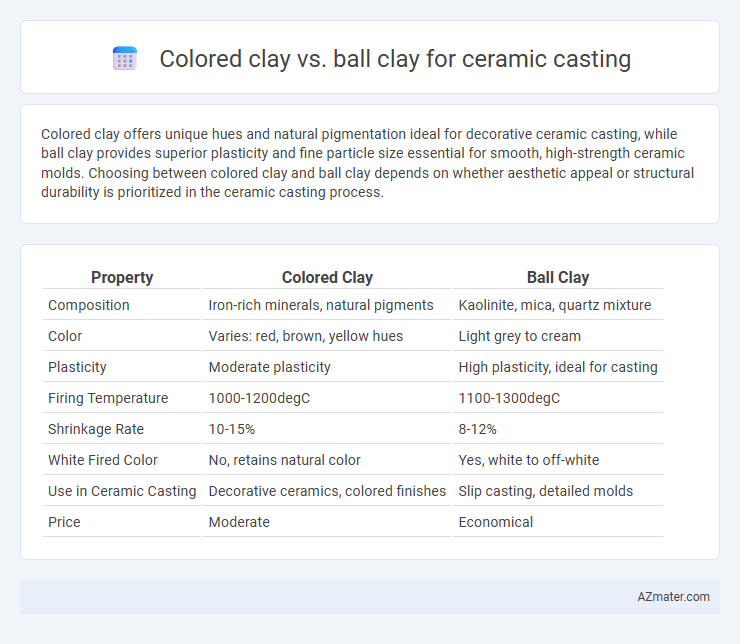Colored clay offers unique hues and natural pigmentation ideal for decorative ceramic casting, while ball clay provides superior plasticity and fine particle size essential for smooth, high-strength ceramic molds. Choosing between colored clay and ball clay depends on whether aesthetic appeal or structural durability is prioritized in the ceramic casting process.
Table of Comparison
| Property | Colored Clay | Ball Clay |
|---|---|---|
| Composition | Iron-rich minerals, natural pigments | Kaolinite, mica, quartz mixture |
| Color | Varies: red, brown, yellow hues | Light grey to cream |
| Plasticity | Moderate plasticity | High plasticity, ideal for casting |
| Firing Temperature | 1000-1200degC | 1100-1300degC |
| Shrinkage Rate | 10-15% | 8-12% |
| White Fired Color | No, retains natural color | Yes, white to off-white |
| Use in Ceramic Casting | Decorative ceramics, colored finishes | Slip casting, detailed molds |
| Price | Moderate | Economical |
Introduction to Ceramic Casting Clays
Colored clay offers unique aesthetic properties with natural pigments ideal for decorative ceramic casting, while ball clay provides superior plasticity and strength essential for forming detailed molds and enhancing greenware durability. Ball clay's fine particle size and high plasticity improve casting slip consistency and reduce drying shrinkage, making it a preferred choice for structural integrity in ceramic production. Colored clays are often blended with ball clay to balance workability and visual appeal in ceramic casting processes.
What Is Colored Clay?
Colored clay is a type of natural clay that contains a high concentration of metal oxides, which impart distinct hues such as red, yellow, or brown, making it ideal for ceramic casting without needing additional pigments. Unlike ball clay, which is prized for its fine particle size, plasticity, and white firing color, colored clay provides inherent coloration and texture to ceramic pieces. Its mineral composition and firing temperature influence the final color and strength, allowing artists to achieve unique aesthetic effects in ceramic casting projects.
What Is Ball Clay?
Ball clay is a fine-grained, highly plastic sedimentary clay composed mainly of kaolinite, mica, and quartz, prized for its strength, plasticity, and white firing characteristics in ceramic casting. Unlike colored clay, which contains iron oxides and other minerals giving it distinct hues, ball clay remains relatively color-neutral, providing superior workability and enhancing the mechanical properties of ceramic casts. Its consistent particle size distribution and low impurities make ball clay ideal for producing smooth, defect-free ceramic surfaces and improving the moldability of slip casting bodies.
Key Differences Between Colored Clay and Ball Clay
Colored clay contains natural pigments that impart distinct hues, making it ideal for decorative ceramic casting, while ball clay is primarily valued for its fine particle size and high plasticity, enhancing moldability and strength. Ball clay has a higher kaolinite content and lower iron oxide levels compared to colored clay, contributing to its white firing characteristics and optimal binder properties. Colored clay often exhibits more variable shrinkage rates and firing temperatures due to its mineralogical diversity, affecting the final appearance and structural integrity of ceramic casts.
Workability and Plasticity Comparison
Colored clay exhibits lower plasticity compared to ball clay, making it less flexible during ceramic casting processes. Ball clay's superior workability and high plasticity enhance moldability, allowing for intricate shapes and smoother surfaces. The fine particle size and mineral composition of ball clay contribute significantly to its excellent casting performance versus colored clay.
Firing Temperatures and Color Outcomes
Colored clay typically contains natural pigments that mature at mid-range firing temperatures between 1,000degC and 1,200degC, resulting in vibrant, stable hues post-firing. Ball clay, known for its fine particle size and plasticity, fires white to off-white at higher temperatures around 1,200degC to 1,300degC and serves primarily as a filler to improve workability without significantly affecting color. Selecting the appropriate clay depends on achieving desired color vibrancy and firing temperature compatibility for ceramic casting projects.
Strength and Durability Characteristics
Colored clay typically contains higher amounts of iron oxides and other minerals, enhancing aesthetic appeal while maintaining moderate strength and durability for ceramic casting. Ball clay exhibits superior plasticity and fine particle size, resulting in excellent green strength and fired durability, making it ideal for intricate casting molds. While colored clay offers decorative benefits, ball clay provides enhanced mechanical resilience and consistency for durable ceramic products.
Aesthetic Effects in Finished Ceramics
Colored clay offers vibrant natural pigments that enhance aesthetic effects, producing unique hues and textures in finished ceramics without the need for added glazes. Ball clay, known for its fine particle size and plasticity, provides a smooth and uniform surface, allowing intricate details and sharp lines but typically requires stains or glazes for color effects. Combining colored clay with ball clay in ceramic casting optimizes both vibrant coloration and fine textural detail for superior visual appeal.
Suitability for Various Casting Techniques
Colored clay offers excellent suitability for slab casting and hand-building techniques due to its vibrant pigmentation and structural integrity. Ball clay, known for its fine particle size and high plasticity, excels in slip casting and intricate mold work, providing smooth surfaces and detailed finishes. Selection between colored clay and ball clay depends on the desired ceramic texture, color, and casting method requirements.
Choosing the Right Clay for Your Ceramic Project
Choosing the right clay for ceramic casting depends on the project's color, texture, and firing requirements; colored clay offers natural pigmentation, reducing the need for surface decoration, while ball clay is prized for its plasticity, fine particle size, and strength in casting slips. Ball clay's high plasticity ensures excellent moldability and minimal shrinkage, making it ideal for intricate or detailed ceramics, whereas colored clay provides unique aesthetic qualities but may require careful firing to maintain color vibrancy. Understanding the specific properties of each clay type allows artisans to achieve desired finishes, structural integrity, and optimal functionality in their ceramic pieces.

Infographic: Colored clay vs Ball clay for Ceramic casting
 azmater.com
azmater.com